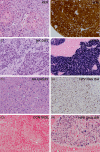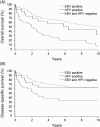Epstein-Barr virus and human papillomaviruses as favorable prognostic factors in nasopharyngeal carcinoma: A nationwide study in Finland
- PMID: 30549170
- PMCID: PMC6590344
- DOI: 10.1002/hed.25450
Epstein-Barr virus and human papillomaviruses as favorable prognostic factors in nasopharyngeal carcinoma: A nationwide study in Finland
Abstract
Background: Nasopharyngeal carcinoma (NPC) is related to Epstein-Barr virus (EBV) in endemic areas; however, the role of viruses in nonendemic countries is unclear. Our nationwide study investigated the prevalence and prognostic significance of EBV and human papillomaviruses (HPVs) in Finnish NPC tumors.
Methods: We analyzed samples from 150 patients diagnosed between 1990 and 2009. Viral status was determined using EBV and HPV RNA in situ hybridizations, and p16 immunohistochemistry. Patient and treatment characteristics were obtained from patient records.
Results: In our white patient cohort, 93 of 150 (62%) patients were EBV-positive and 21/150 (14%) patients were HPV-positive with no coinfections. Thirty-six (24%) tumors were negative for both viruses. The 5-year disease-specific survival for patients with EBV-positive, HPV-positive, and EBV/HPV-negative tumors was 69%, 63%, and 39%, respectively. In multivariable-adjusted analysis, overall survival was better among patients with EBV-positive (P = .005) and HPV-positive (P = .03) tumors compared to patients with EBV/HPV-negative tumors.
Conclusions: In our low-incidence population, EBV and HPV are important prognostic factors for NPC.
Keywords: Epstein-Barr virus; human papillomavirus; nasopharyngeal carcinoma; p16 immunohistochemistry; viral carcinogenesis.
© 2018 The Authors. Head & Neck published by Wiley Periodicals, Inc.
Figures


Similar articles
-
Expression of toll-like receptors in non-endemic nasopharyngeal carcinoma.BMC Cancer. 2019 Jun 25;19(1):624. doi: 10.1186/s12885-019-5816-9. BMC Cancer. 2019. PMID: 31238894 Free PMC article.
-
Epstein-Barr virus and human papillomavirus serum antibodies define the viral status of nasopharyngeal carcinoma in a low endemic country.Int J Cancer. 2020 Jul 15;147(2):461-471. doi: 10.1002/ijc.33006. Epub 2020 Apr 24. Int J Cancer. 2020. PMID: 32279316
-
Human papillomavirus and Epstein-Barr virus in nasopharyngeal carcinoma in a low-incidence population.Head Neck. 2014 Apr;36(4):511-6. doi: 10.1002/hed.23318. Epub 2013 Jun 18. Head Neck. 2014. PMID: 23780921 Free PMC article.
-
Viral markers in nasopharyngeal carcinoma: A systematic review and meta-analysis on the detection of p16INK4a, human papillomavirus (HPV), and Ebstein-Barr virus (EBV).Am J Otolaryngol. 2021 Jan-Feb;42(1):102762. doi: 10.1016/j.amjoto.2020.102762. Epub 2020 Oct 20. Am J Otolaryngol. 2021. PMID: 33202328
-
Epstein-Barr Virus DNA in Nasopharyngeal Carcinoma: A Brief Review.Methods Mol Biol. 2020;2204:99-107. doi: 10.1007/978-1-0716-0904-0_9. Methods Mol Biol. 2020. PMID: 32710318 Review.
Cited by
-
A Distinct Anti-EBV DNase Profile in Patients with Undifferentiated Nasopharyngeal Carcinoma Compared to Classical Antigens.Viruses. 2023 Oct 26;15(11):2158. doi: 10.3390/v15112158. Viruses. 2023. PMID: 38005835 Free PMC article.
-
Human Papillomavirus-Related Carcinomas of the Sinonasal Tract.Curr Otorhinolaryngol Rep. 2022 Sep;10:291-302. doi: 10.1007/s40136-022-00404-7. Epub 2022 May 11. Curr Otorhinolaryngol Rep. 2022. PMID: 36311560 Free PMC article.
-
Co-incidence of Human Papillomaviruses and Epstein-Barr Virus Is Associated With High to Intermediate Tumor Grade in Human Head and Neck Cancer in Syria.Front Oncol. 2020 Aug 20;10:1016. doi: 10.3389/fonc.2020.01016. eCollection 2020. Front Oncol. 2020. PMID: 32974123 Free PMC article.
-
Comparing serum protein levels can aid in differentiating HPV-negative and -positive oropharyngeal squamous cell carcinoma patients.PLoS One. 2020 Jun 15;15(6):e0233974. doi: 10.1371/journal.pone.0233974. eCollection 2020. PLoS One. 2020. PMID: 32542012 Free PMC article.
-
Epidemiology and treatment outcome of nasopharyngeal carcinoma in a low-incidence population - a DAHANCA analysis in Denmark 2000-2018.Acta Oncol. 2024 Nov 4;63:850-857. doi: 10.2340/1651-226X.2024.40499. Acta Oncol. 2024. PMID: 39492804 Free PMC article.
References
-
- Schiller JT, Lowy DR. Virus infection and human cancer: an overview. Recent Results Cancer Res. 2014;193:1‐10. - PubMed
-
- Bouvard V, Baan R, Straif K, et al. A review of human carcinogens—Part B: biological agents. Lancet Oncol. 2009;10:321‐322. - PubMed
-
- Rickinson AB. Co‐infections, inflammation and oncogenesis: future directions for EBV research. Semin Cancer Biol. 2014;26:99‐115. - PubMed
-
- Tsai M, Raykova A, Klinke O, et al. Spontaneous lytic replication and epitheliotropism define an Epstein‐Barr virus strain found in carcinomas. Cell Rep. 2013;5:458‐470. - PubMed

